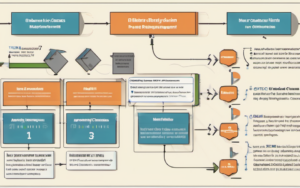The world of blockchain technology has undergone a dramatic transformation since the inception of Bitcoin. While Bitcoin revolutionized digital currency, Ethereum introduced a new paradigm that expanded the possibilities of blockchain beyond just financial transactions. This pioneering platform introduced the concept of smart contracts, giving birth to a vibrant ecosystem of decentralized applications and a decentralized financial revolution.
Ethereum’s Origins and Innovation
Ethereum’s journey began in 2013 with Vitalik Buterin, a young programmer, who envisioned a blockchain that could execute code and enable decentralized applications. The platform was officially launched in 2015, quickly gaining traction for its revolutionary features.
The Need for Smart Contracts
Traditional contracts often require intermediaries to enforce agreements, which can be costly and time-consuming. Ethereum introduced the concept of smart contracts, self-executing code stored on the blockchain that automatically enforces agreements without the need for intermediaries. This innovation opened up a vast range of possibilities, enabling decentralized applications to be built on a secure and transparent foundation.
Ethereum’s Unique Features
Ethereum’s success can be attributed to its unique features:
- Turing-Complete: This means Ethereum’s virtual machine can execute any type of code, allowing for complex applications to be built on the platform.
- Gas Fees: Ethereum uses a gas system to pay for computational resources, ensuring a fair and efficient allocation of resources within the network.
- Decentralized Governance: Ethereum’s decentralized governance structure allows for community participation in network upgrades and improvements.
Ethereum’s Impact on the Blockchain Landscape
Ethereum’s impact on the blockchain landscape has been profound, driving innovation across various sectors.
Decentralized Applications (DApps)
Ethereum’s smart contract functionality paved the way for the development of decentralized applications (DApps). These applications operate on a decentralized network, removing the need for central authorities and fostering a more transparent and secure environment. DApps have emerged in various sectors, including gaming, finance, supply chain management, and social media.
The Rise of DeFi
Decentralized Finance (DeFi) has become a major force within the blockchain ecosystem, and Ethereum is at the forefront. DeFi applications like lending platforms, decentralized exchanges, and stablecoins provide alternative financial services that are accessible to anyone with an internet connection.
NFTs and the Metaverse
Non-fungible tokens (NFTs) have taken the world by storm, and Ethereum has become the dominant platform for creating and trading NFTs. NFTs represent unique digital assets, including artwork, collectibles, and virtual real estate, fueling the growth of the metaverse, a virtual world where users can interact with digital assets and experiences.
Ethereum’s Future and Challenges
As Ethereum continues to evolve, it faces several challenges that need to be addressed to ensure its long-term success.
Scalability and Gas Fees
One of the biggest challenges facing Ethereum is scalability. The network’s capacity to process transactions is limited, resulting in high gas fees, particularly during periods of high network activity. Ethereum is actively working on solutions to improve scalability, such as Ethereum 2.0, which will introduce Proof-of-Stake consensus and sharding, significantly increasing transaction throughput.
Competition and Innovation
The blockchain space is constantly evolving, with new competitors emerging and innovative solutions being developed. Ethereum needs to remain at the forefront of innovation to maintain its dominance. This includes exploring new technologies and adapting to the changing needs of the industry.
Regulation and Adoption
As the blockchain industry matures, regulation is becoming increasingly important. Ethereum needs to navigate the regulatory landscape while promoting responsible adoption of blockchain technology across different sectors.
Ethereum’s Future
Ethereum’s future is bright, with the potential to become an integral part of the global economy. As the platform continues to evolve and address its challenges, it will likely play a crucial role in shaping the future of blockchain technology and its impact on various industries.
The continued development of Ethereum and its ecosystem will continue to drive innovation, foster financial inclusion, and create new opportunities for individuals and businesses. With its commitment to decentralization, security, and innovation, Ethereum is poised to remain a dominant force in the blockchain landscape for years to come.




